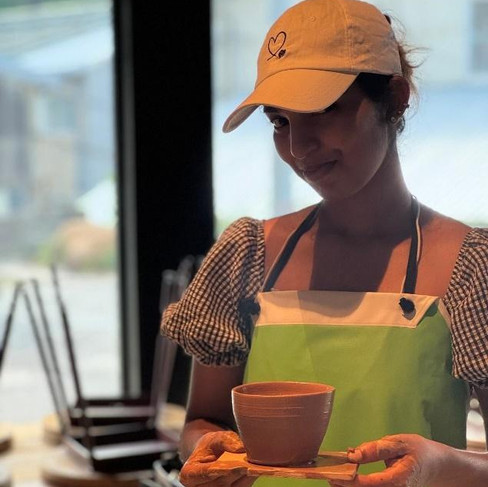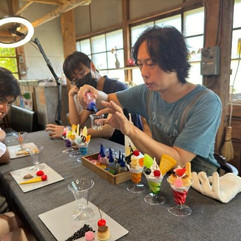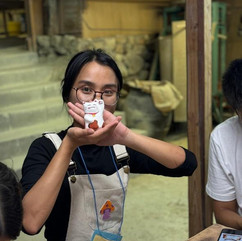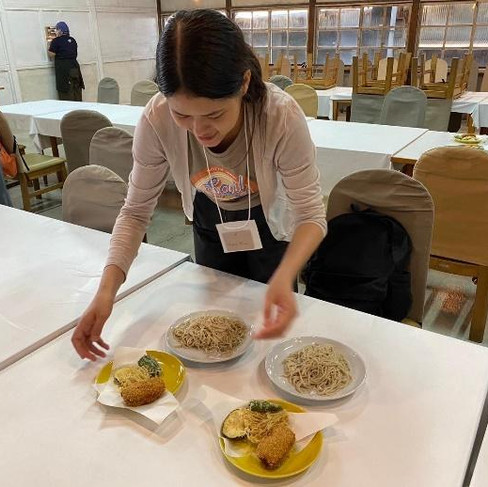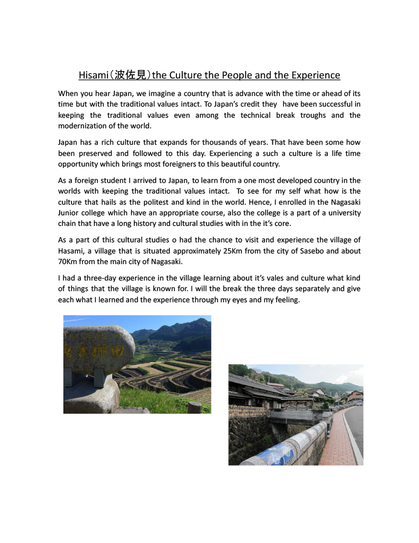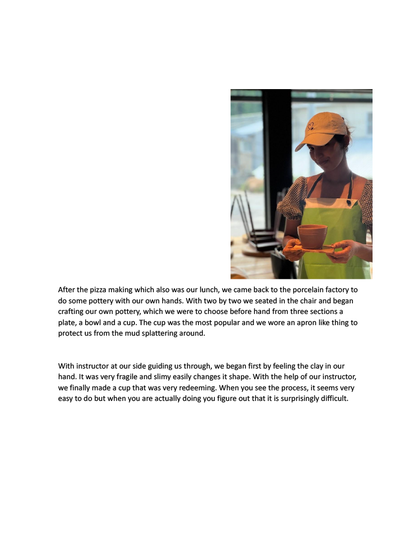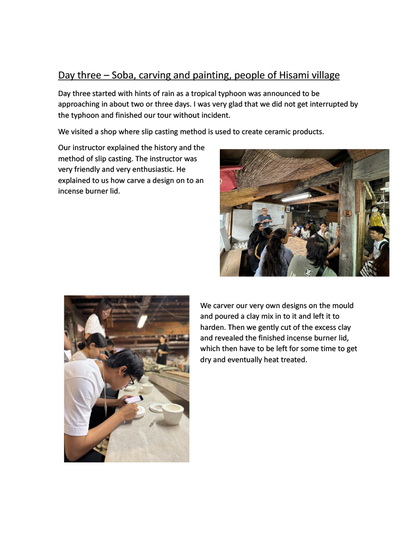This site is available in multiple languages. Please select your preferred language from the bar at the bottom right.
Craft Kyushu | A report from an international student living in Kyushu about the real experiences and excitement of traditional crafts

HERATH MUDIYANSELAGE HARSHAN SHALIKA
Hasami - Culture, People and Experiences
When we hear about Japan, we imagine a country that is ahead of its time and that continues to uphold traditional values. Japan is highly regarded for having held fast to its traditional values even amid technological breakthroughs and the wave of global modernization.
Japan has a rich culture that spans thousands of years and has somehow managed to be preserved until today. Experiencing this culture is a once in a lifetime opportunity and is one of the reasons why so many foreigners visit this beautiful country.
I came to Japan as a foreign student to study in one of the most developed countries in the world while still respecting traditional values. I wanted to see for myself the Japanese culture, which is said to be one of the most polite and hospitable in the world. So I enrolled in Nagasaki Junior College, which is part of a chain of universities in Nagasaki with a focus on history and cultural studies, and had the right courses.
As part of my cultural studies, I had the opportunity to visit a village called Hasami and learn about its culture, values, and what the village is known for. Hasami Village is located about 25 km from Sasebo City and about 70 km from the center of Nagasaki City. I would like to share what I learned and felt during my three days in the village, divided into each day, and share how I perceived Hasami's culture and experiences with my own eyes and heart.
Day 1 - Hasami Village, Pottery, and Pizza On the first day, we learned about the village of Hasami and what it is known for. Hasami is a village famous for its pottery and ceramics. This industry has a history of over 400 years. It is said that the village has its own production methods. Hasami also has a mine for extracting the raw materials for ceramics, which it uses to make its famous ceramics.
Hasami ceramics have a very distinctive style. In the past, indigo patterns printed on white porcelain were common, but today there are many different patterns and designs. These patterns were once hand-painted, but with the introduction of new technology they are now printed by machine, greatly increasing the speed and efficiency of production.
We toured Hasami's ceramic production facility and got to see up close how intricate ceramics are made. They make all kinds of tableware for homes and restaurants, from plates to teapots to cups. My country also has a ceramics industry, but it is not rooted in village culture. Also, while the industry in Sri Lanka is run by a few companies and a small number of people, Hasami is a very different place in that the industry is a part of life, with a tradition that has been going on for over 400 years.
After the tour of the production factory, we went to a pizza restaurant where we experienced making pizzas under the guidance of an elderly pizza maker. Hasami village is not famous for pizza, but it was a very fresh and fun experience. Making it ourselves doubled the fun, and the experience was very valuable.
We started by kneading the dough, rolling it into balls, and letting it rest. In the meantime, we started cutting the vegetables. How we cut the vegetables was left to each person's preference and creativity, and everyone enjoyed it as if it were their own art. The pizza chef was always nearby, quickly correcting any mistakes and giving accurate advice. The time we spent rolling out the pizza dough and adding our own toppings to make pizzas was a very memorable experience. Each pizza made that day was unique, and each one showed their own creativity.
After making pizza (which also became our lunch), we went back to the pottery factory and experienced pottery with our own hands. We sat down in pairs and started making our own creations from three types of items we had selected in advance: plates, bowls, and cups. The cups were particularly popular, and we wore something like aprons to protect ourselves from mud splashes.
With their instructors providing careful support, the children first got to feel the feel of the clay in their hands. Clay is very delicate and slippery, and can be easily shaped. With the instructors' help, they were finally able to create their very own cup, which gave them a great sense of accomplishment. The process may seem simple, but it proved to be surprisingly difficult when they actually tried it. And so, the first day came to an end as the children took home their precious works, made with their own hands, and watched them being sent to the kiln to be fired.
Day 2 - Hasami Museum, food sample making, ceramic painting, accessory making
The second day began with a visit to the Hasami History and Culture Museum. The museum introduces the history of Hasami from prehistoric times to the present day, and also features stories of important historical figures who contributed to Hasami's development. The museum also has a section dedicated to the prehistoric era, when dinosaurs roamed the earth, where replicas of dinosaur bones as well as parts of actual bones are on display. There are also detailed explanations and videos, allowing you to deepen your knowledge of the prehistoric era.

Afterwards, we visited a food replica workshop and created our own food replicas. Food replicas are life-size examples of dishes that are displayed in the storefronts of restaurants and cafes to attract customers. These replicas are common in Japan, but I've always wondered what goes on behind the scenes in their creation. There is almost no food replica culture in my country, and even if there are, very few that look as delicious as the real thing.
Under the guidance of the instructor, we tried to make ice cream models. The process of making ice cream models while freely choosing colors and toppings was not easy, but it required dexterity and was a very fun experience. I am satisfied with the finished food model, but to be honest, my work was less beautiful than the others (laughs). Afterwards, we all had a little fun.
Afterwards, we had the chance to make our own art designs on ceramic cups. We chose from several types of stickers and created our own designs to express our artistic taste. Under the guidance of our instructor, we were able to finish very well. All the designs were beautiful, unique and interesting. Afterwards, we had lunch.
Afterwards, we headed down to the river to begin our expedition-like search for ceramic fragments that are thousands of years old. We went upstream and found and collected many ceramic fragments. We brought the fragments back to shore and, together with our instructor, assessed their age and the period they belonged to.
Then, we made accessories using the old pieces. Using flexible wire and glue, everyone made necklaces. This work required a lot of patience, but in the end, we were able to complete a beautiful looking necklace. This was the end of the third day's activities.
Day 3 - Soba making, carving and painting, people of Hasami village
The third day began with light rain as a tropical typhoon was forecast to approach in the next few days. We were relieved to be able to complete the tour without being hindered by the typhoon. We visited a shop that uses a method called "slip casting" to make ceramic products.
Our instructor explained the history and methods of slip casting. He was very kind and enthusiastic and also showed us how to carve a design into the lid of the incense holder. We carved our design into a mould, poured the clay mixture into it and left it to harden. The excess clay was then carefully cut away to reveal the finished incense holder lid, which was then dried and finally fired to finish.
Next, we painted cat figurines with watercolors. It was a really fun experience. We each chose a theme and made colorful cats, which left us feeling very satisfied and happy.
After that, I started making lunch, which was soba noodles, cold soba noodles to be exact, and it was a lot of work: if you're not careful, the flour and water will just turn into a lump and become unusable.
As always, the instructor carefully guided us, but kneading and stretching the dough is really hard work and requires all our effort. After many failures, we finally managed to complete the soba with the instructor's help.
After that, the soba noodles were boiled and we had tempura (a type of Japanese fried food that comes in a variety of varieties, including vegetables and cutlets) that were prepared for us to enjoy together. We dipped the soba noodles in a soy sauce-based broth with salt and wasabi to taste. After that, we started making lunch.
Lunch was soba noodles, cold soba noodles to be exact, which was quite a task, as if you weren't careful the flour and water would just turn into a lump and become unusable.
As always, the instructor carefully guided us, but kneading and stretching the dough is really hard work and requires all our effort. After many failures, we finally managed to complete the soba with the instructor's help.
After that, the soba noodles were boiled and served with tempura (a type of Japanese fried food that comes in a variety of varieties, including vegetables and cutlets). We ate the soba noodles with soy sauce-based broth, which we added salt and wasabi to taste.
After lunch, we had time to mingle with local people, sharing our experiences with the people who supported and guided us during these three days.
We discussed what it means to the people of Hasami to have foreigners visit and promote the culture and history of the village. We also discussed how the pandemic has affected the industry, and what there is to see and experience in Hasami from a cultural perspective, adventure, and scenery. After a very informative discussion, it was time to head home after a wonderful experience.
Hasami Village was a very meaningful place for me to gain cultural knowledge and new experiences. It has successfully turned ordinary crafts into a tourist resource, and grown into a place for cultural experiences that many people want. It is also working on new initiatives so that visitors can experience not only the culture but also the modern side of the area.
All of this made me feel that Hasami was a place worth visiting and a place where I could have a cultural experience that would be a lifelong memory. After lunch, we had time to mingle with the local people, sharing our experiences with the people who had supported and guided us during these three days.
We discussed what it means to the people of Hasami to have foreigners visit and promote the culture and history of the village. We also discussed how the pandemic has affected the industry, and what there is to see and experience in Hasami from a cultural perspective, adventure, and scenery. After a very informative discussion, it was time to head home after a wonderful experience.
Hasami Village was a very meaningful place for me to gain cultural knowledge and new experiences. It has successfully turned ordinary crafts into a tourist resource, and grown into a place for cultural experiences that many people want. It is also working on new initiatives so that visitors can experience not only the culture but also the modern side of the area.
All of this made me feel that Hasami was a place worth visiting and a place where I could have a cultural experience that would be a lifelong memory. After lunch, we had time to mingle with the local people, sharing our experiences with the people who had supported and guided us during these three days.
We discussed what it means to the people of Hasami to have foreigners visit and promote the culture and history of the village. We also discussed how the pandemic has affected the industry, and what there is to see and experience in Hasami from a cultural perspective, adventure, and scenery. After a very informative discussion, it was time to head home after a wonderful experience.
Hasami Village was a very meaningful place for me to gain cultural knowledge and new experiences. It has successfully turned ordinary crafts into a tourist resource, growing into a place where many people can experience culture. New initiatives are also being undertaken so that visitors can experience not only the culture but also the modern side of the area. In these respects, I felt that Hasami is a place worth visiting, a place where you can have a cultural experience that will become a lifelong memory.

Report
Report language :
English





















